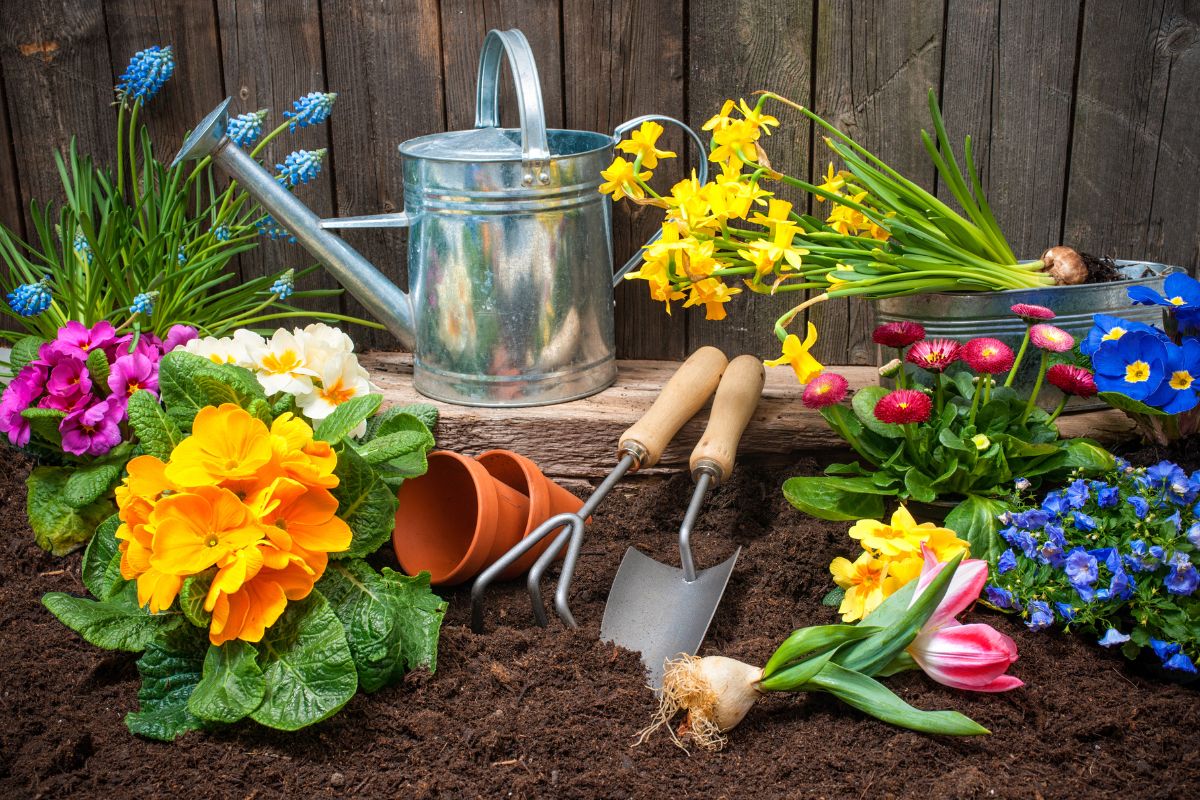
5 Natural Pest Control Tips Every Gardener Should Know
Spring weather marks the start of a new season of garden growth. As blooms begin, the temperature swings and wetter weather also encourage insect activity, and these pests are ready to wreak havoc on your garden.
Many garden pests hibernate during the colder months, and the warmer soil and longer days prompt them to emerge. New larvae hatch in these same conditions, increasing the pest population. Spring weather also spurs new plant growth, which provides pests with a smorgasbord on which to feed. And because the new shoots are weaker and less resilient than their established counterparts, they make the perfect target for garden pests who feed on them.
The cost of insect infestations is sobering. These pests cause 20 to 40 percent of crop loss across the globe, amounting to up to $70 billion in damage each year. A moderate to high aphid infestation of wheat crops in Montana, Idaho, Washington, and Oregon alone can lead to $120 million in economic losses.
Despite the potential damages, growers can manage pest populations. Now is the time to take action, as preventative measures are far more effective than reactive remedies.
This blog covers 5 highly effective and natural pest control tips. Plus, we’ll share why not all ‘natural’ pest controls are created equal.
Know Your Enemy: Common Garden Pests in Spring and Summer
You should regularly examine your crops for signs of insect activity. Keep your eye out for some of the most common garden pests, including aphids, whiteflies, spider mites, thrips, and more. Knowing what to look for in your garden enables you to treat the problem early and stave off a full-blown infestation.
Here are a few fast facts and warning signs for these frequently found garden pests:
Aphids

These small insects range in color from red, yellow, green, brown, or black. Their distinguishing characteristic is cornicles, tubelike structures that extend from the back of their body. Dense groups of them feed on unopened flower buds, or plant stems, leaves, shoots, and roots, and excrete a sugary substance called honeydew.
Warning signs:
- Leaf damage. Leaves may be yellowed, curled, or distorted
- Shoot damage. Shoots may be stunted or die off
- Black, sooty mold. Fungus may develop on honeydew. Look for a black, sooty appearance
Whiteflies

Related to aphids, scales, and mealybugs, their name comes from the mealy, white wax that covers their bodies and wings. Whiteflies feed on plant sap using piercing mouth pieces and, like aphids, excrete honeydew.
Warning signs:
- Leaf damage. Leaves may turn yellow, appear dry, be sticky, or fall off
- Black sooty mold. The honeydew residue may grow mold that is black and powdery
- Ants. Ants are attracted to the honeydew excretions
Spider Mites

Microscopic spider mites have six legs as larvae but as they mature, these wingless mites have eight legs just like their spider relatives. They damage foliage by sucking juices, usually from the leaves.
Warning signs:
- Leaf discoloration. Leaves may turn pale yellow
- Leaf stippling or bronzing. Leaves may have yellow or white spots. Some species of leaves turn bronze after, or instead of, stippling
- Webbing. Fine webbing may appear between leaves and on new growth
Thrips

These tiny insects have slender bodies and may have fringed wings, although they are known to be weak fliers. There are 5,000 known species of thrips and some varieties are benign, feeding on pollen and fungal spores instead of plants. Others pierce a plant’s cell wall to feed, causing varying degrees of damage.
Warning signs:
- Leaf appearance. Silvery scratches may be noticeable on the tops of leaves, and foliage may become wrinkled or withery
- Leaf drop and damage. Foliage may turn brown or bronze. Some premature leaf drop may also occur
- Fruit damage. Fruit may be scarred, scabby, or deformed
Prevention Starts with Good Garden Habits

The best pest control starts before insects appear, and IPM (Integrated Pest Management) is a form of natural pest control that not only works to prevent pest outbreaks but also helps your garden thrive.
- Start with healthy soil. Rich, healthy soils are the basis of good pest management. Fresh soil is full of nutrients that keep your plants healthy and improve their resilience, so they are strong enough to withstand pest damage. Healthy soil contains beneficial organisms that compete with and help to curb pests, and doesn’t contain harmful fungi and organisms that can weaken your plants.
- Plant mutually beneficial plants together. Companion planting is an organic method of gardening that deters insects while also avoiding soil compaction, maximizing garden space, and reducing diseases. Pairing different scents and colors together confuses garden pests that target particular species. For instance, strong scents deter whiteflies, so try planting marigolds, basil, or peppermint with your tomatoes and turnips. Dill and garlic repel aphids and spider mites and are great to pair with roses. Take care not to pair plants with vastly different light or moisture needs. Tomatoes, for example, need full sun and would not thrive if you pair them with sunflowers or cornstalks, which will provide too much shade..
- Keep your garden weed free. Frequently weed your garden to ensure your plants are not competing with weeds for soil nutrients. Monitor your foliage for signs of water stress, which can weaken your plants and make them more susceptible to pests. Regularly and routinely check stems and leaves carefully for signs of pest activity. (Good garden maintenance also applies to your tools—sanitize them between uses to avoid potentially spreading anything among your plantings.)
Smarter, Safer Natural Control Methods
Despite your best efforts, garden pests will inevitably find your foliage. When this happens, two additional IPM practices will help you manage the insects before they become an infestation:
-
Encourage beneficial insects. Let nature help you fight insects by attracting their natural predators to your garden. Beneficial insects like spiders, ladybugs, bees, lacewing beetles, praying mantises, and birds will feed on common garden pests. Learn what attracts them and incorporate it into your garden.
For instance, beetles like shade, which is why you often see them when you move a flower pot or a log. Build a rock, stick, leaf, or compost pile near your garden to create a beetle habitat. Planting brightly colored and scented blooms will bring bees and birds who are seeking sources of pollen. To attract ladybugs, grow herbs like dill and cilantro or flat-top flowers like alyssum, yarrow, or marigold.
-
Be picky about your pest spray. The market is flooded with pesticides and insecticides meant to keep pests under control. However, these chemical treatments create serious negative environmental consequences, not to mention many insects develop immunity to this kind of treatment—rendering them useless for pest control.
Growers searching for “natural” products often turn to options like neem and mineral-based horticultural oils. However, just because a label says something is natural doesn’t mean it can’t cause harm. For instance, biodegradable neem oil can burn foliage, contaminate plants, reduce their yield, and change the smell and taste of plants on which it has been applied.
Solutions that are both effective, and gentle, on your garden's ecosystem are the safest form of pest control. GrowSafe, a 100% food-grade and non-toxic product, is effective against a wide range of pests. GrowSafe is OMRI-listed by the Organic Materials Review Institute, which means the products used within its solution are 100% organic. The rating certifies that it is environmentally friendly if it gets into the soil, and is safe for people, pets, pollinators and beneficial insects that come in contact with it. Unlike neem oil, GrowSafe will not change the smell or taste of herbs and botanicals, fruits, or vegetables.
When applied directly to infested plants, GrowSafe kills pests on contact. Made from food-grade corn, soybean, sunflower and coconut oils and citric acid, GrowSafe thoroughly coats impacted plants with this proprietary mixture to kill insects. The coating means that, with regular reapplication, GrowSafe serves as a shield for your plant, preventing additional pests from targeting your plants.
Grow smart, GrowSafe

Pest control is an ongoing process and practicing it regularly is part of a healthy garden ecosystem. For the best pest prevention, proactively use IPM measures, inspect your foliage frequently, and ensure the products you use are not simply “natural,” but are safe for your pollinators, beneficial insects, and the environment. Your plants, and our planet, will thank you.
